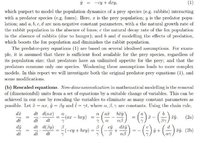luvs2spooge
New member
- Joined
- Jan 19, 2020
- Messages
- 4
I need to substitute in [MATH]x =\frac{1}{[A]} [/MATH] and then show [MATH]\dot{x}[/MATH] in terms of [MATH]A[/MATH] via the chain rule, then show a derivation or [MATH]\dot{x}[/MATH]. So there should not be any [MATH][A][/MATH] left.
This is the equation that I have so far.
[MATH]\frac{1}{[A]^{2}}\times\dot{[A]} = \frac{\omega}{[A]}- \frac{\omega}{N} - \frac{\alpha}{[A]}[/MATH]
This is the equation that I have so far.
[MATH]\frac{1}{[A]^{2}}\times\dot{[A]} = \frac{\omega}{[A]}- \frac{\omega}{N} - \frac{\alpha}{[A]}[/MATH]

